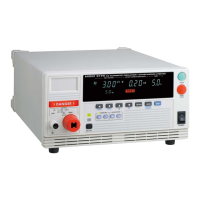8.6 Timing Chart
116
During a test decision
The figure shows the timing chart of the instrument in PASS state after a test. In
PASS state, the TEST
signal indicates HIGH level.
The H.V.ON
signal remains at LOW level provided that the voltage between the
output terminals remains unchanged, as the signal is synchronized with the
DANGER lamp. (Below 30 V AC when performing an AC-withstand voltage test,
or below 60 V DC when performing an insulation-resistance test.) Once the volt-
age reaches 0, the signal changes to HIGH level. The PASS
signal changes
according to the indicator on the fluorescent display. If the PASS hold
function is enabled, the PASS
signal continues to indicate LOW level until the
function is disabled.
When the Hold function is disabled or the instrument automatically returns to the
READY state, the PASS
signal becomes HIGH level and the READY signal
becomes LOW level.
Withstand-voltage test (When the PASS hold function is not used)
Insulation-resistance test (When the PASS hold function is not
used)
Even in the FAIL state, when UPPER FAIL is activated, the U-FAIL signal
becomes LOW level. Similarly, with LOWER-FAIL, the L-FAIL
signal becomes
LOW level. If a withstand-voltage test fails, the W-FAIL
signal becomes LOW
level. Similarly, if an insulation-resistance test fails, the I-FAIL
signal becomes
LOW level.
When the FAIL Hold function is set, the signal remains at LOW level until the
Hold function is disabled.
When the Hold function is disabled or the instrument automatically returns to the
READY state, the PASS
signal becomes HIGH level and the READY signal
becomes LOW level.
Approx. 300 ms
READY
TEST
H.V.ON
PASS
Voltage
Output
READY
TEST
H.V.ON
PASS
Voltage
Output
Approx. 300 ms

